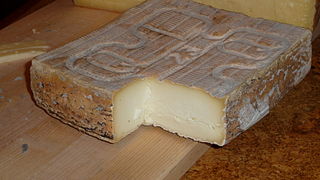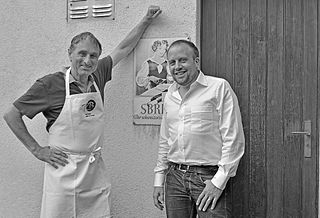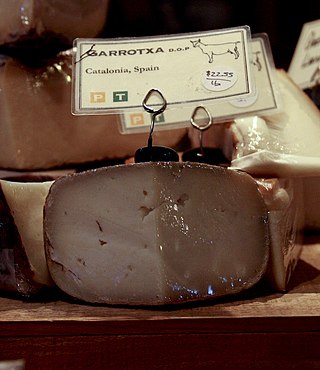
Cheddar cheese is a natural cheese that is relatively hard, off-white, and sometimes sharp-tasting. Cheddar originates from the English village of Cheddar in Somerset.

Wensleydale is a style of cheese originally produced in Wensleydale, North Yorkshire, England, but now mostly made in large commercial creameries throughout the United Kingdom. The term "Yorkshire Wensleydale" can only be used for cheese that is made in Wensleydale. The style of cheese originated from a monastery of French Cistercian monks who had settled in northern England, and continued to be produced by local farmers after the monastery was dissolved in 1540. Wensleydale cheese fell to low production in the early 1990s, but its popularity was revitalized by frequent references in the Wallace and Gromit series.

Stilton is an English cheese, produced in two varieties: Blue, which has Penicillium roqueforti added to generate a characteristic smell and taste, and White, which does not. Both have been granted the status of a protected designation of origin (PDO) by the European Commission, requiring that only such cheese produced in the three counties of Derbyshire, Leicestershire and Nottinghamshire may be called Stilton. The cheese takes its name from the village of Stilton, now in Cambridgeshire, where it has long been sold.

Taleggio is a semisoft, washed-rind, smear-ripened Italian cheese that is named after Val Taleggio. The cheese has a thin crust and a strong aroma, but its flavour is comparatively mild with an unusual fruity tang.

Dunlop is a mild cheese or 'sweet-milk cheese' from Dunlop, East Ayrshire, Scotland. It resembles a soft Cheddar cheese in texture. Though it fell out of popularity some time after the end of the Second World War, it is now appreciated for its value in various recipes and for eating on its own or with a dram of whisky.

Rolf Beeler is a Swiss affineur known for his raw milk artisan cheeses. He does not make cheese himself but collects terroir-based cheeses from small artisanal cheesemakers and then ages them to create the final product.

Époisses, also known as Époisses de Bourgogne, is a legally demarcated cheese made in the village of Époisses and its environs, in the département of Côte-d'Or, about halfway between Dijon and Auxerre, in the former duchy of Burgundy, France, from agricultural processes and resources traditionally found in that region.

Shropshire Blue is a cow's milk cheese made in the United Kingdom.

Garrotxa is a traditional Catalan goat cheese. Almost extinct by the early 1980s, it has been revived by a young cheesemakers and goat farmers' cooperative in the Garrotxa area of Catalonia. The revival began in 1981, and the cheese has since become widespread in artisanal production.
Harbourne Blue is a goat's cheese produced by Ben Harris at Ticklemore Cheese Company in Devon, near Totnes, England. It is made by hand by using local milk. Maturation is around 10 weeks in which it forms a crumby, dense and firm texture with 48% fat content. It can easily overwhelm milder cheeses as the flavours are spicy and assertive.
Norbury Blue is an English blue cheese made in Surrey. It is entirely handmade and the only blue cheese made in the South of England with milk from a closed herd of Friesian cows, fed on GM-free fodder. The cheese was made at the Dairy at Norbury Park Farm until 2018, when production moved to Sherbourne Farm at Albury.

Walkers Snack Foods Limited, trading as Walkers, is a British snack food manufacturer mainly operating in the UK and Ireland. The company is best known for manufacturing potato crisps and other (non-potato-based) snack foods. In 2013, it held 56% of the British crisp market. Walkers was founded in 1948 in Leicester, England, by Henry Walker. The Walkers family sold the business in 1970 to American food producer, Standard Brands. In 1989, Walkers was acquired by Lay's owner, Frito-Lay, a division of PepsiCo.

Swaledale is a full fat hard cheese produced in the town of Richmond in Swaledale, North Yorkshire, England. The cheese is produced from cows’ milk, Swaledale sheep's milk and goats’ milk.

Glyde Farm Produce was set up in 1996 by Peter Thomas who spent the next several years researching the market in Ireland for suitable dairy products. Peter and Anita Thomas started making Bellingham Blue cheese at their family farm at Mansfieldtown in County Louth, Ireland, in 2000.

Sheep milk cheese is a cheese prepared from sheep milk. Well-known cheeses made from sheep milk include the feta of Greece, Roquefort of France, manchego from Spain, the pecorino romano and ricotta of Italy. Yogurts, especially some forms of strained yogurt, may also be made from sheep milk.

Max McCalman is an American cheese scholar and advocate for artisanal cheese production. He is an author, was the first Maître Fromager in a North American restaurant, spearheaded the creation of the Artisanal Bistro and Artisanal Premium Cheese Center, and is an advocate for raw-milk cheeses.

Oxford Blue is a variety and brand of blue cheese produced in Burford, Oxfordshire, England in 1995 by French baron Robert Pouget in the tradition of Stilton cheese but with a creamier consistency especially when the cheese was allowed to mature. It is a soft and creamy cheese that has tangy, aromatic and spicy qualities. By 2013, around five tonnes were produced monthly.















